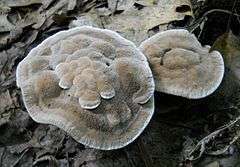Hydnellum spongiosipes
Hydnellum spongiosipes, commonly known as the velvet tooth,[2] is a tooth fungus in the family Bankeraceae. It is found in Europe and North America.[3] In Switzerland, it is considered a vulnerable species.[4]
| Hydnellum spongiosipes | |
|---|---|
 | |
| Scientific classification | |
| Kingdom: | |
| Division: | |
| Class: | |
| Order: | |
| Family: | |
| Genus: | |
| Species: | H. spongiosipes |
| Binomial name | |
| Hydnellum spongiosipes | |
| Synonyms[1] | |
Taxonomy
The fungus was originally described as new to science in 1898 by American mycologist Charles Horton Peck, who placed it in the genus Hydnum.[5] Zdeněk Pouzar transferred it to Hydnellum in 1960.[6] Synonyms include Hydnellum nuttallii, published by Howard James Banker in 1906, and Hydnellum velutinum var. spongiosipes, published by Rudolph Arnold Maas Geesteranus in 1957.[1]
gollark: The void stares back into void nebulæ, and occasionally eats them and everything around them.
gollark: Huh, maybe blacks are just miscoloured nebulæ.
gollark: Void nebs?
gollark: ~~use strikethrough, TJ09 can't hear it~~
gollark: ~~spying on us~~
References
- "GSD Species Synonymy: Hydnellum spongiosipes (Peck) Pouzar". Species Fungorum. CAB International. Retrieved 2015-01-11.
- "Recommended English Names for Fungi in the UK" (PDF). British Mycological Society. Archived from the original (PDF) on 2011-07-16.
- Pegler DN, Roberts PJ, Spooner BM (1997). British Chanterelles and Tooth Fungi. Kew, UK: Royal Botanic Gardens. pp. 88–89. ISBN 978-1-900347-15-0.
- Senn-Irlet B, Bieri G, Egli S (2007). Lista Rossa Macromiceti. Lista Rossa delle specie minacciate in Svizzera. UV-0718-I (Report) (in Italian). Bern: Ufficio federale dell’ambiente.
- Peck CH. (1897). "Report of the State Botanist (1896)". Annual Report on the New York State Museum of Natural History. 50: 77–159 (see p. 111).
- Pouzar Z. (1960). "The Kersko forest in the Central Elbe Region". Ceská Mykologie. 14 (2): 129–32.
This article is issued from Wikipedia. The text is licensed under Creative Commons - Attribution - Sharealike. Additional terms may apply for the media files.